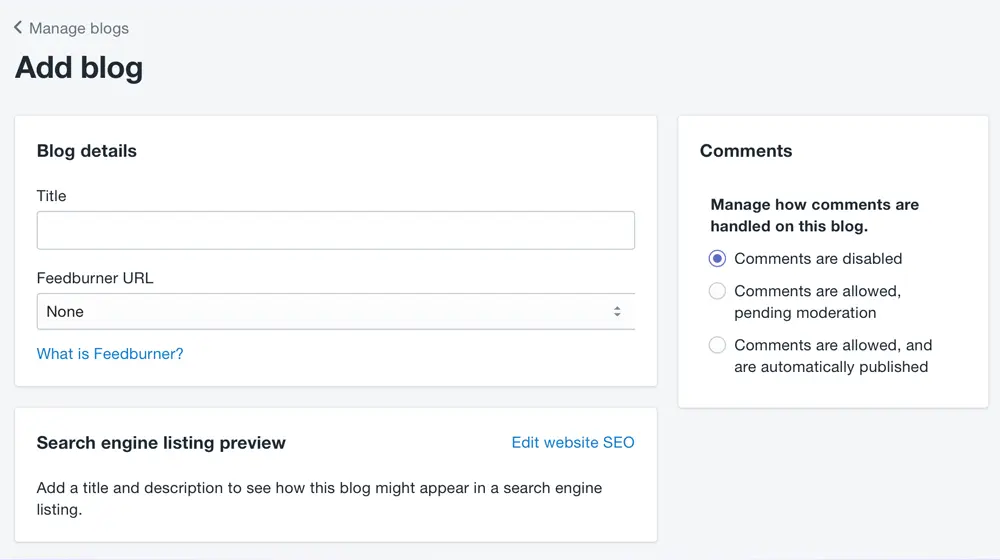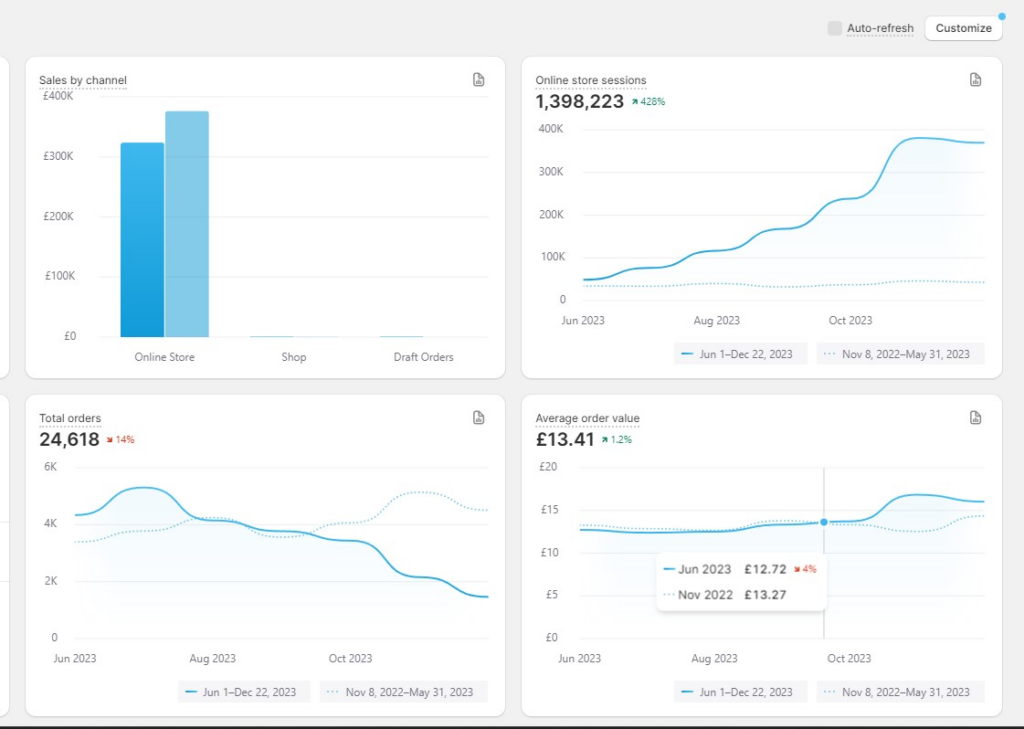Are you dreaming of building a website where your store and blogs thrive together, helping each other?
Shopify is a leading e-commerce giant, which is a perfect fit for running an online store, and possibly, blogging too.
Wait my friend before you jump for publishing your first blog! Shopify does have features a built-in blogging engine, but it is no secret that its main strength lies in the e-commerce segment.
That’s where the big question arises: is Shopify good for blogging?
While we can say yes you can, it needs brief discussion, and that’s what this guide is all about.
We’ll explore the ease of blogging with Shopify, its customizability, SEO features, and more. This way, you can figure out if Shopify is the perfect fit for your blogging journey or if another one might be better.
Let’s dive into the pros and cons of Shopify for your blogging ambitions.
Should I Use Blogging For My E-Commerce Store?
Blogging is a huge chunk of your e-commerce marketing strategy and nearly 2.8 million blogs are written every day. This is huge, and the count is increasing as time goes on.
Starting a new e-commerce store, and thinking whether or not to incorporate blogging into it? In this case, you need to calculate where your effort goes further.
Utilizing blogging for your e-commerce store is a strategic move. Blogs are undeniably a vital aspect for literally any business.
Blogging comes with a plethora of advantages. It enhances your online presence, boosts SEO, and establishes your store as an industry authority.
Besides, It engages customers, drives traffic, and contributes to a long-term marketing strategy. Adding engaging content attracts potential customers while building trust and loyalty.
Is It Okay To Use Shopify For Blogging?
Choosing between Shopify and WordPress for your blog? If simplicity is key, Shopify is your go-to. With just a few clicks on your Shopify site, you can add and run a blog within minutes.
On the flip side, WordPress offers more flexibility and options with numerous plugins, ideal for power users fine-tuning complex systems.

Source: ContentPowered
However, if you’re after quick setup, basic SEO control, and a streamlined blog experience, Shopify is perfect.
Plus, Shopify blogs seamlessly match your store’s theme, eliminating the need for additional customization.
If you’re new to blogging or online business, Shopify’s blogging system suits most needs without the hassle of later migration.
Key Reasons For Blogging On Your Shopify Store
Blogging on your Shopify store isn’t just about products; it’s about sharing stories, tips, and cool stuff. It boosts your store’s SEO game, bringing in more visitors.
Plus, it makes your store a go-to spot for info and keeps customers coming back for more. It’s like giving your store a voice in the online crowd – personal, engaging, and totally worth it!
Let’s discuss some of the key reasons for blogging on your Shopify store:
1. Turn Traffic Into Leads
When you blog on Shopify, it’s like having a secret weapon to turn your website visitors into leads. Just whip up some cool content that your potential customers find useful, and voila!
You can get them to sign up for emails or join surveys. It’s a sneaky-good way to build awesome relationships with your customers and rack up more leads as time goes on.
2. Adds SEO Advantages
When you create content that’s all set for search engines like Google, you’re not just writing; you’re boosting your store’s visibility in search results and pulling in more organic traffic.
Shopify throws in handy tools like meta tags and Open Graph data, making it even easier to amp up your blog posts for SEO.
And guess what? Blogging on Shopify doesn’t break the bank. By optimizing your posts, you’re unlocking more free traffic to your store.
Forget pricey ad campaigns – content marketing’s got your back, bringing your goodies to the right audience without burning a hole in your wallet!
3. Deliver Value to Customers
To be better than others, make sure your customers get something valuable. Blogging on Shopify helps with that.
You can create interesting content that matters to your customers. When you use blogging in your digital marketing plan, it lets you connect with customers.
You can tell them about new stuff, upcoming deals, and more. It’s a great way to keep them in the loop!
4. Boosts Traffic
Blogging helps bring more people (traffic) to your website and make more people aware of your brand.
When you share helpful and interesting content, it attracts visitors who are interested in what you offer. This can eventually lead to more sales and conversions for your business.
5. Teach Your Customers
Blogging on Shopify is a great way to share helpful information with your customers. You can break down tricky ideas or share the coolest trends in your industry through blog posts.
Building trust is key, and it lets your customers know they can always rely on you for the freshest and most reliable info.
Imagine this: Your shop sells cookware. Spice up your Shopify blog with some fantastic recipes! Teach your customers how to cook up delicious meals using your products.
It’s the kind of content that sparks excitement and might just turn those recipe readers into happy customers!
6. Spread the Word
Blogs are like a megaphone for your store. Sharing your posts on social media opens the gateway for more people to discover your business.
In return, it builds brand awareness and makes your store more trustworthy over time. Think of it as making new friends who might love your stuff!
7. Increase Interaction
Shopify blogs aren’t just about information overload. They’re a chance to connect with your customers! Respond to comments, answer questions, and have conversations.
You know what it does? It builds a whole community who are genuinely interested in your brand. This is way cooler than just having followers.
8. Share Store Updates
Use your Shopify blog to share all the juicy news about your store. New products? Upcoming sales? Exciting updates? Share them here!
Sharing your store news keeps your audience in the loop. This makes them feel like part of the journey. All in all, it strengthens that special bond you have with them.
9. Establish Trust Blog Categories
Share tips, tutorials, industry news, or a peek into your company’s culture to connect with your audience.
Adding a blog to your Shopify store positions you as an industry expert, fostering trustworthiness and credibility.
People want to know what happens behind the scenes, hear your thoughts, and gain useful information about your products – all satisfied by the Shopify blog.
10. Helps Sell Your Products
Running out of space in product descriptions? A blog steps in! It lets you talk directly to customers, sharing how your products fit into their lives and solve their problems.
Don’t miss adding clear calls-to-action (CTAs) linking back to your products for a seamless shopping experience!
11. Get Long-Term Benefits
Blogging is like planting seeds for your business that keep growing. It’s an evergreen strategy to drive long-term benefits for your e-commerce store.
When you regularly share content and connect with customers, it sets up a continuous flow of leads and sales over the long haul.
What Are The Pros And Cons Of Blogging On Shopify?
Thinking about starting a blog on Shopify? Well, blogging on Shopify has its merits and drawbacks. Let’s chat about the pros and cons of blogging on Shopify!
Pros of Blogging on Shopify:
Convenience:
Ease of Use:
Additional Benefits:
Cons of Blogging on Shopify:
Limited customization:
Cost:
Other Considerations:
5 Steps To Create Shopify Blogs Easily
Let’s dive into creating your blog on Shopify! Creating a blog on Shopify is a breeze, especially when you follow these simple steps:
1. Choose Your Niche
Alright, let’s kick off your Shopify blog journey! The key first step?
Pick a niche that vibes with your products. It will make your content shine brighter and make it a breeze for readers to find out exactly what they’re after.
If you are planning to run a store of handmade jewelry, think of unique designs, cool DIY projects, and the latest industry trends – you got this!
2. Pick Your Platform
Time to pick your blogging home! After deciding on your niche, consider Shopify.
It’s a hassle-free, hosted platform that lets you create a blog in minutes. Choose from cool templates and give your blog the vibe you want.
3. Choose a Theme
Consider your theme as your blog’s style – an expression of your brand that creates a certain vibe.
Shopify provides various themes for you to customize your blog’s appearance. When picking one, think about the content you’ll share and the atmosphere you want to create.
4. Select a Catchy Name
Pick a blog name that reflects your brand and stands out. Aim for something memorable and creative, like ‘Bakers’ Tales’ if you’re into handmade bakery items.
5. Prepare Your Content Plan
Get your content game plan ready! Before you begin writing, take your time, and make a plan for your content.
It can be a list of topics or a detailed outline with clear goals. This helps you stay focused and create content that matters to your readers.
Having a proper and curated plan helps stay you on the right track and ensures your article hits the right notes for your audience.
Grow Your Organic Traffic Quickly With AI Buster
Though Shopify is good for blogging, but it is pretty tricky to do all those things at a stance to get the desired results. Nothing to stress!
We have a tool – AI Buster, which can make it easy. For your record, AI Buster helped a Shopify Store reach a revenue from £800 to £325K with nearly 1.3 Million organic traffic.
Have a look at the stats graph:

Here’s how Ai Buster can help your Shopify blogging:
Automate Shopify blogs using the powerful GPT 3.5 and 4 models of AI Buster. Experience SEO-optimized articles that are detailed, reader-friendly, and consistently captivating.
Conclusion
It’s easy to get lost in all the content noise and you can’t avoid being part of this content world.
Shopify is a versatile platform, seamlessly blending e-commerce and blogging features.
Despite some limitations compared to WordPress, its simplicity, adaptability, and integrated approach make it a valuable choice for businesses seeking a unified online presence.
The decision ultimately depends on your priorities and specific blog requirements. And if you’re determined to move on with Shopify blogging, don’t forget to try AI Buster.
After setting up your Shopify blog, let your customers know about your products and sell more with SEO traffic.




